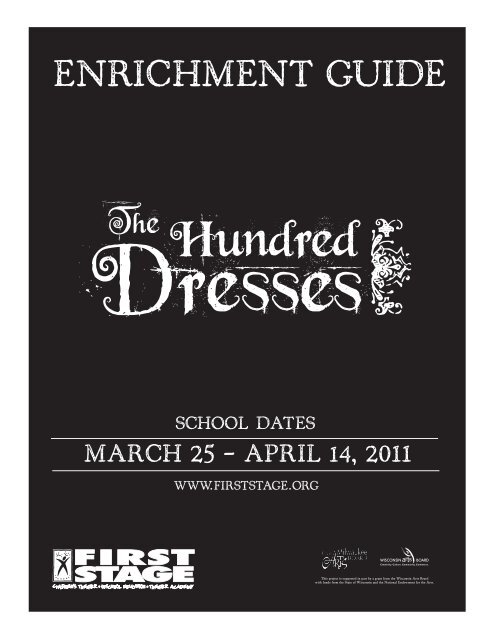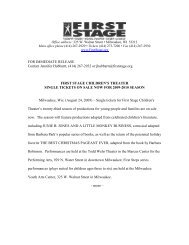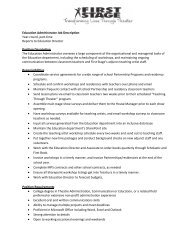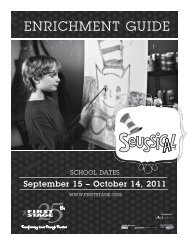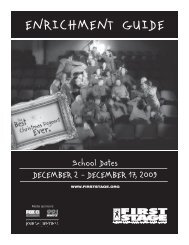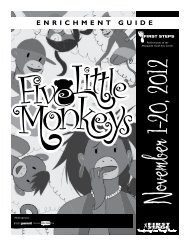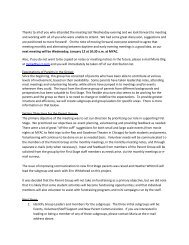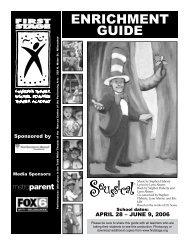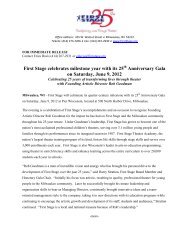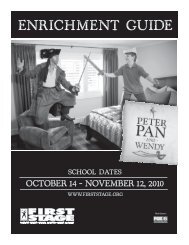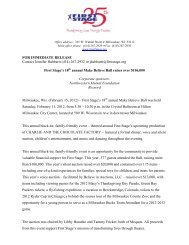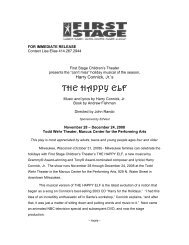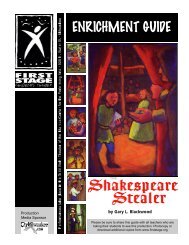The Hundred Dresses Enrichment Guide - First Stage
The Hundred Dresses Enrichment Guide - First Stage
The Hundred Dresses Enrichment Guide - First Stage
Create successful ePaper yourself
Turn your PDF publications into a flip-book with our unique Google optimized e-Paper software.
ENRICHMENT GUIDE<br />
SCHOOL DATES<br />
MARCH 25 – APRIL 14, 2011<br />
WWW.FIRSTSTAGE.ORG<br />
This project is supported in part by a grant from the Wisconsin Arts Board<br />
with funds from the State of Wisconsin and the National Endowment for the Arts.
Inside the <strong>Guide</strong><br />
A Note to Teachers and Parents<br />
Setting the <strong>Stage</strong><br />
preparing for the play<br />
Synopsis. ................ 2-3<br />
About the Playwright ......... 4<br />
About the Author. ........... 4<br />
Recommended Reading. ....... 5<br />
Pre-Show Questions. ......... 5<br />
For Teachers<br />
Curriculum connections before or<br />
after the play<br />
SOCIAL STUDIES<br />
Polish Immigration to America<br />
in the Early 1900s............... 6<br />
1938: Life During the Great Depression,<br />
Leading up to World War II...... 7-8<br />
New Student Welcoming Plan..... 10<br />
SOCIAL AND EMOTIONAL<br />
WELLBEING<br />
What Does Compassion Look Like... 9<br />
<strong>The</strong> Peaceful Person............ 12<br />
What Would You Do: Combating<br />
Bullying Situations ............. 13<br />
LANGUAGE ARTS<br />
<strong>The</strong> Friendly Letter: Righting Wrongs..<br />
. . . . . . . . . . . . . . . . . . . . . . . . . . . .11<br />
Dear Teachers and Parents,<br />
As part of our commitment to young people and educators in our community, <strong>First</strong> <strong>Stage</strong><br />
Children’s <strong>The</strong>ater provides families and school groups with opportunities to take part in programs<br />
and performances designed to examine the different forms of bullying that occur in the school<br />
community, while working further to promote respect and tolerance among classmates and teach<br />
tactics in problem solving, positive conflict resolution, and overcoming obstacles. We are pleased<br />
to have the opportunity to partner with your school district to aid in your anti-bullying efforts.<br />
Enclosed in this enrichment guide is a range of materials and activities intended to help you<br />
discover connections within the play through the curricula. It is our hope that you will use the<br />
experience of attending the theater and seeing THE HUNDRED DRESSES with your students<br />
as a teaching tool. As educators and parents, you know best the needs and abilities of your<br />
students. Use this guide to best serve your children—pick and choose, or adapt, any of these<br />
suggestions for discussions or activities. We encourage you to take advantage or the enclosed<br />
student worksheets— please feel free to photocopy the sheets for your students, or the entire<br />
guide for the benefit of other teachers.<br />
Enjoy the show!<br />
Julia Magnasco<br />
Education Director<br />
(414)267-2971<br />
<strong>First</strong> <strong>Stage</strong> Policies<br />
Curtain Call<br />
Post-Show Discussion Questions ... 14<br />
Who Said It?.................. 14<br />
Who Said It? (Answers).......... 15<br />
• <strong>The</strong> use of recording equipment and cameras are not permitted during the performance.<br />
• Food, drink, candy and gum are not permitted during the performance.<br />
• Electronic devices are not permitted in the theater space.<br />
• Should a student become ill, suffer an injury or have another problem, please escort him<br />
or her out of the theater space.<br />
• In the unlikely event of a general emergency, the theater lights will go on and the stage<br />
manager will come on stage to inform the audience of the problem. Remain in your seats,<br />
visually locate the nearest exit and wait for the stage manager to guide your group from<br />
the theater.<br />
Seating for people with disabilities: If you have special seating needs for any student(s) and<br />
did not indicate your need when you ordered your tickets, please call our School Sales<br />
Specialist at (414) 267-2962. Our knowledge of your needs will enable us to serve you<br />
better upon your arrival to the theater.
Setting the <strong>Stage</strong>: Synopsis<br />
It is mid-September of 1938 in<br />
the small town of Boggins Heights,<br />
Connecticut and Peggy and her best<br />
friend are racing each other down<br />
the street. <strong>The</strong>y taunt each other<br />
about Mr. Svenson coming to get<br />
them, a man that lives on the street<br />
that all the children fear. As they are<br />
playing, they hear the eerie sound of<br />
a wind instrument and blame it on<br />
a ghost that lives in Mr. Svenson’s<br />
house. <strong>The</strong>y huddle together, enjoying<br />
being scared, yet Maddie is not<br />
sure. Peggy tells Maddie of how her<br />
dad thinks Mr. Svenson is a criminal<br />
and good for nothing. Maddie<br />
tries to defend him. Peggy races<br />
off to the bridge, leaving Maddie<br />
behind with the eerie noises, shutters banging, a creaky<br />
door. Peggy calls for her and, frightened, Maddie runs off<br />
to meet her. Just then, Wanda, a Polish immigrant holding<br />
a recorder, enters from the house watching Maddie leave.<br />
One week later in the schoolyard fifth-grade classmates<br />
Willie, Jack, Peggy, Maddie and Cecile are playing. Willie<br />
is bragging about playing a prank on Mr. Svenson. <strong>The</strong>y<br />
all listen attentively giggling at his antics. Willie then dares<br />
a reluctant Jack to steal his hat. Jack agrees and the boys<br />
shake on it. <strong>The</strong>y run off. <strong>The</strong> girls begin to play four square.<br />
Wanda enters, unnoticed, and stands away from the kids by<br />
the wall. As the girls play and talk, Maddie is the only girl<br />
to notice Wanda, but she ignores her. <strong>The</strong> boys return, and<br />
as everyone rushes into the school, nobody takes notice to<br />
Wanda who is in plain view of all. She walks in the school<br />
alone.<br />
In the classroom, the children’s teacher, Miss Mason, is<br />
continuing their social studies lesson. Cecile interrupts to<br />
ask Miss Mason about the drawing contest, something that<br />
all of the children are eagerly anticipating. Miss Mason<br />
explains the contest: the boys will draw motor boats, the<br />
girls dresses. Winners will be announced November 1 and<br />
they will receive a medal as a prize. Miss Mason continues<br />
the geography lesson, much to the dismay of the class.<br />
Students take turns reading aloud. It is Wanda’s turns and<br />
is clear that she is scared to read aloud. She reads with<br />
difficulty as Miss Mason kindly and gently helps her along.<br />
Willie continues reading next as Mr. Petronski, Wanda’s<br />
father enters the classroom. Wanda is embarrassed as her<br />
father gives her the recorder she left<br />
at home. <strong>The</strong> kids giggle at the different<br />
sounding language. <strong>The</strong> children<br />
file out to go to the library. With all<br />
the kids gone, Wanda hugs her father<br />
and files out. Miss Mason stays back<br />
to compliment his son Jacob who<br />
has been helping out by cleaning the<br />
school.<br />
At Maddie’s house, Maddie is standing<br />
on a stool while her mother,<br />
Shelly, puts trim on a hand-me-down<br />
dress. Maddie asks her mom to hurry<br />
so that Peggy will not find out this<br />
secret. Just as Shelly cuts off the last<br />
thread, Peggy arrives. Peggy begins<br />
to talk about “ol’ man Svenson” and<br />
Shelly scolds her to mind their own<br />
business and leave him alone. <strong>The</strong> girls leave for school.<br />
Wanda and her brother, Jake enter the playground. She<br />
urges her brother to go ahead into the school; she wants to<br />
wait outside. Maddie and Peggy enter singing, passing by<br />
Wanda who is in her usual wall spot. Cecile enters wearing<br />
a beautiful crimson dress and is showered with compliments<br />
from her friends. No one acknowledges Wanda’s presence.<br />
As the girls talk about the pretty things they have, Wanda<br />
creeps quietly near the girls and softly reveal that she has<br />
a hundred dresses. This confuses the girls who begins to<br />
ask her questions in a very mean spirited way – they do not<br />
believe that the girl that wears the same dress everyday<br />
owns a hundred dresses. Peggy and Cecile burst into laughter<br />
as Maddie looks away. Peggy continues to mock her and<br />
is joined by Cecile. Wanda at first enjoys the attention but<br />
soon realizes they are making fun of her. Maddie is somehow<br />
affected by this. <strong>The</strong> bell rings and kids file into school.<br />
Peggy and Maddie are the last ones in. Peggy suggests they<br />
ask her the next day about her dresses because it will be<br />
fun. <strong>The</strong>y run into the school.<br />
Two weeks later, Maddie is haunted by the “hundred dresses<br />
game” that her friends play with Wanda. Shelly walks in<br />
on Maddie trying to write an essay for school. Maddie questions<br />
her mother about the likelihood of someone having a<br />
hundred dresses. Shelley leaves, and leaves Maddie at the<br />
table. She tears out a piece of paper and begins to write<br />
a letter to Peggy asking her to stop the hundred dresses<br />
game. She drifts in a fantasy about standing up to Peggy<br />
2
Setting the <strong>Stage</strong>: Synopsis (Cont.)<br />
and stopping the game. Her fantasy is interrupted when<br />
Shelly comes back and asks how her essay is going. Maddie<br />
is clearly still struggling with the importance of this situation<br />
with Wanda.<br />
On the playground, Peggy and the girls continue with their<br />
game; asking Wanda about her hundred dresses. Jack races<br />
in and says that he took the hat and the dog dish from<br />
Mr. Svenson. Peggy is outraged about the dog dish and<br />
demands he take it back. Willie enters, grabs the hat and<br />
plays keep away with it. Maddie eventually tosses it back to<br />
Jack. As Wanda slinks back to her wall spot, the kids (except<br />
Maddie) giggle and tease her. Jack tells the others he saw<br />
Wanda on Mr. Svenson’s porch. <strong>The</strong> bell rings and Jack and<br />
Cecile go inside. Peggy and Maddie are left with Wanda.<br />
Peggy continues asking about the dresses. Wanda waits<br />
for Maddie to say something, yet she says nothing. Maddie<br />
goes into the school, as Peggy follows she laughs as she<br />
smugly says, “Good bye, Wanda Pe-tron-ski.”<br />
A week later in the classroom, the children are giving their<br />
reports. Peggy and Maddie burst in late. <strong>The</strong>y sit down<br />
quickly in embarrassment. Maddie is distracted during the<br />
lesson and Miss Mason notices her lack of participation.<br />
Maddie is so focused on Wanda’s empty desk that she does<br />
not hear the recess bell. Miss Mason asks her help in hanging<br />
up the boy’s drawings. <strong>The</strong> room is soon transformed<br />
by all of the colorful drawings, particularly the hundred<br />
dresses. <strong>The</strong> students soon race back into the classroom<br />
and are mesmerized by the sight. Miss Mason enters and<br />
awards the winner of the contest, Wanda Petronski. While<br />
most students did one or two drawings, Wanda did a hundred.<br />
<strong>The</strong> kids genuinely applaud. Unfortunately, Wanda<br />
is not there to receive it. Jack receives the medal for his<br />
motor boat drawing. <strong>The</strong> girls look at Wanda’s drawings<br />
with genuine awe and admiration, pointing out their favorites.<br />
Willie returns to the classroom with a letter. <strong>The</strong> letter<br />
is from Wanda’s father, Mr. Petronski, and he explains<br />
that they are moving to the city where they will feel more<br />
welcomed. Miss Mason is upset and addresses the students<br />
about their thoughtlessness. <strong>The</strong> class sits quietly. Finally,<br />
Peggy suggests she and Maddie go to Wanda’s house to see<br />
if she’s still there.<br />
<strong>The</strong> girls arrive at Wanda’s abandoned house. <strong>The</strong>y are<br />
struck by the smallness of this basic one bedroom house.<br />
As they look around, Mr. Svenson surprises them in their<br />
quiet inquiry. Frightened, they try to run away, but Maddie<br />
slips and Mr. Svenson stands back from them. Peggy questions<br />
him about the Petronski’s, but with an unintelligible<br />
grumble, the girls flee.<br />
<strong>The</strong> following Saturday in the schoolyard, Maddie is remembering<br />
Wanda, standing by herself on the playground. Jack<br />
and Willie enter playing and teasing one another. When<br />
Peggy arrives, the two girls begin to write a letter to Wanda,<br />
telling her that she won the drawing contest and complimenting<br />
her drawings. Maddie attempts to perfectly fold<br />
the letter before dropping it into the mailbox. <strong>The</strong> girls run<br />
off to meet their friends at the movie theatre.<br />
As the movie begins, Maddie begins to imagine herself on<br />
the screen, giving a passionate speech about standing up<br />
for Wanda. Her reverie is interrupted by loud cartoon music.<br />
While Peggy is entertained by the cartoon, Maddie can’t<br />
stop thinking about Wanda.<br />
Maddie becomes more anxious everyday she does not hear<br />
back from Wanda. She finally breaks down with her mother<br />
by her side and reveals the whole story to her. Maddie is<br />
worried that Wanda is too angry to write back and will<br />
never forgive them. As Shelly tries to comfort her, Maddie<br />
is overwhelmed by the fact that she didn’t do anything to<br />
help protect Wanda.<br />
Jack is sneaking nervously around Mr. Svenson’s house. He<br />
hides as Maddie approaches. She and Jack have a bit of a<br />
standoff and Jacks leaves. Tentatively she creeps up to his<br />
porch and places a roled up piece of paper on his steps. Mr.<br />
Svenson appears and startles her. She apologizes that Jack<br />
took his hat and offers her drawing of his dog. <strong>The</strong>y both<br />
remember the Petronski’s and share their mutual fondness<br />
for them. <strong>The</strong>y sit together for a moment and then Maddie<br />
leaves.<br />
Two weeks later in school, the class receives a letter from<br />
Wanda. Maddie becomes very still as Miss Mason reads the<br />
letter. In the letter, Wanda gives her drawings to the girls<br />
in the class. <strong>The</strong> boys begin to talk about another prank<br />
that they plan to pull on Mr. Svenson. As the others laugh,<br />
Maddie tries to stop them from making fun of him. Jack<br />
stays back as the others leave and gives Maddie back the<br />
dog dish he stole from Mr. Svenson.<br />
Maddie and her mother enter, unbundling themselves from<br />
a cold walk. Maddie has just been telling Shelly about how<br />
Mr. Svenson is so nice. As Maddie sits down to do her<br />
homework, she drifts into another one of her daydreams.<br />
This time, Wanda is beautifully dressed and the girls are<br />
laughing and playing. Peggy enters carrying Maddie’s geography<br />
book. <strong>The</strong> girls take out the pictures that Wanda gave<br />
them and realize that the girls wearing the dresses look like<br />
them. Maddie still questions whether or not Wanda will ever<br />
forgive them.<br />
3
About the Playwright<br />
Taken from: http://www.dramaticpublishing.com/AuthorBio.php?titlelink=9920<br />
Mary Hall Surface<br />
Mary Hall Surface’s work has been featured at Seattle Children’s <strong>The</strong>atre, Dallas<br />
Children’s <strong>The</strong>atre, Arizona’s Childsplay, Honolulu <strong>The</strong>atre for Youth, as well as ten productions<br />
at the Kennedy Center in Washington, D.C. , in every region of the US, as well as in Ireland, France,<br />
Peru, Germany, Italy and across Canada. An anthology of five of her plays, Most Valuable Player and<br />
Four Other All-Star Plays for Middle and High School Audiences was published by Smith and Kraus.<br />
She has been nominated for four Helen Hays Awards for Outstanding Direction -- for the Round House<br />
<strong>The</strong>atre’s TINTYPES (‘93), for TFA’s GRIMM TALES (‘00), SING DOWN THE MOON (‘01) and PERSEUS<br />
BAYOU (‘02) (for which she recieved the award) and for the Charles MacArthur Award for Outstanding<br />
New Play for SING DOWN THE MOON, PERSEUS BAYOU and MISSISSIPPI PINOCCHIO (all three written<br />
with composer David Maddox). A national leader in her field, she was the director of New Visions<br />
2000: One <strong>The</strong>atre World, a national festival of theatre for young people and families, co-produced<br />
by the Kennedy Center and ASSITEJ/USA in May 2000. Her recent projects include A LIGHT IN THE<br />
STORM, based on the book by Karen Hesse, which opened at the Kennedy Center in October 2001 and<br />
THE ODYSSEY OF TELEMACA, her sixth collaboration with David Maddox, which premiered at<br />
<strong>The</strong>ater of the <strong>First</strong> Amendment in June 2004.<br />
About the Author<br />
Taken from: http://en.wikipedia.org/wiki/Eleanor_Estes<br />
Eleanor Estes<br />
Eleanor Estes (May 9, 1906 – July 15, 1988) was an American children’s author. She was born in<br />
West Haven, Connecticut as Eleanor Ruth Rosenfield. She worked as a children’s librarian in New Haven,<br />
Connecticut, and New York. Estes’ writing career began following a case of tuberculosis. Bedridden<br />
while recovering, Estes began writing down some of her childhood memories, which would later<br />
turn into full-length children’s books.<br />
Estes attended the Pratt Institute Library School. She married William McGreal and they lived in New<br />
Hampshire. She later taught at the University of New Hampshire Writer’s Conference.<br />
Estes’ book Ginger Pye (1951) won the Newbery Medal, and three of her other books (<strong>The</strong> Middle<br />
Moffat, Rufus M., and <strong>The</strong> <strong>Hundred</strong> <strong>Dresses</strong>) were chosen as Newbery Honor books. She also received the<br />
Certificate of Award for Outstanding Contribution to Children’s Literature and was nominated for the<br />
Laura Ingalls Wilder Award. By the time of her death at age 82, Estes had written 19 children’s books<br />
and one novel for adults.<br />
Her papers are at the University of Southern Mississippi and University of Minnesota.<br />
4
Recommended Reading<br />
• <strong>The</strong> Moffats by Eleanor Estes<br />
• <strong>The</strong> Middle Moffat by Eleanor Estes<br />
• Rufus M. by Eleanor Estes<br />
• <strong>The</strong> Moffat Museum by Eleanor Estes<br />
• Ginger Pye by Eleanor Estes<br />
• <strong>The</strong> Family Under the Bridge by Natalie<br />
Savage Carlson<br />
• A Grain of Rice by Helena Clare Pittman<br />
• <strong>The</strong> Courage of Sarah Noble by Alice Dalgliesh<br />
• <strong>The</strong> Light at Tern Rock by Julia L. Saue<br />
• A Day’s Work by Eve Bunting<br />
• Say Something by Peggy Moss<br />
• Nobody Knew What to Do: A Story about Bullying<br />
by Becky Ray McCain<br />
• My Secret Bully by Trudy Ludwig<br />
Pre-Show Questions<br />
1. In the play, THE HUNDRED DRESSES, a new girl in school is the target of bullying. Why do you think she is<br />
picked on? Have you ever noticed a situation at school where someone is being bullied?<br />
2. Wanda is a Polish immigrant that moves into a small town in Connecticut. What challenges do you think that<br />
she and her family have before them?<br />
3. Have you ever been new to a school? How did you feel on your first day? What was difficult? Was it easy to<br />
meet people and make friends? Or, have you ever had a new student in your class? How did you react; did<br />
you .welcome them or were did you see others welcome them?<br />
4. <strong>The</strong> girls at Wanda’s school are constantly competing over who has the prettiest and the most dresses. Is<br />
there something (clothes, shoes, cell phones) at your school where students try to outdo each other? How<br />
does it affect their actions or the way they treat each other? Are there students that don’t get involved with<br />
these social pressures? Why do you think they choose not to compete with others?<br />
5. <strong>The</strong> story, THE HUNDRED DRESSES, was published in 1944, yet the story is still relevant today. How do you<br />
think .the play will appeal to a modern audience? What do you expect to see in the design (set, costumes,<br />
props)?<br />
5
Polish Immigration to America in the Early 1900s<br />
SOCIAL STUDIES CLASSROOM INFORMATION<br />
Taken from: Polish Immigration to America from the 1800s to 1980s http://www.suite101.<br />
com/content/polish-immigration-to-america-from-the-1800s-to-1980s-a243912#ixzz1CkIVeBy3<br />
L ike many Eastern Europeans in the 19th century, Polish<br />
people were also looking for a better way of life. In<br />
Poland in the 1800s, the quality of life was quite poor for<br />
the average Pole. Usually, they worked on farms, making<br />
a very small sum of money. Children were raised to take<br />
over the farm after their parents were too old to work<br />
or after they died. <strong>The</strong> dream of opportunity in America<br />
beckoned many Poles to this new nation.<br />
<strong>The</strong> first wave of Polish immigrants to the U.S. was from<br />
the late nineteenth century to World War I. At this time,<br />
Poland was not yet a country. Instead, the area was split<br />
between Prussia, Austria and Russia. So U.S. immigration<br />
registered them from these three countries. At the same<br />
time, Polish Jews immigrated to America as well, as Hitler and the German forces began invading Eastern<br />
European countries and eliminating the Jewish population.<br />
Polish people immigrated to cities such as New York and Chicago. <strong>The</strong>y lived in filthy conditions, for example,<br />
many immigrants inhabited the slums on the Lower East Side of Manhattan at the time. <strong>The</strong>y became laborers<br />
and worked long hours for little pay. However, it was more pay than they made back in their native Poland.<br />
<strong>The</strong> second wave of immigration hit after World War II. <strong>The</strong> brutal war destroyed Poland and its population.<br />
Poland lost more citizens to the war than any other country, totaling six million victims. This second wave<br />
of Polish immigration was made up of political prisoners and dissidents and refugees from European camps.<br />
Many of these first generation immigrants took great pains to assimilate smoothly. <strong>The</strong>y established themselves<br />
as working class Americans with goals of moving upwards to the upper middle class. Poland was a<br />
distant memory.<br />
6
1938: Life During the Great Depression, Leading up to World War II<br />
SOCIAL STUDIES/HISTORY CLASSROOM INFORMATION<br />
Taken from: http://newdeal.feri.org/eleanor/er2a.htm, http://www.allabouthistory.org/life-during-the-great-depression.htm, http://www.thepeoplehistory.<br />
com/1938.html, http://library.thinkquest.org/J002606/1930s.html, http://edhelper.com/ReadingComprehension_35_161.html<br />
<strong>The</strong> Great Depression<br />
<strong>The</strong> decade of the 1930s saw the Great Depression in<br />
the United States and many other countries. During<br />
this decade large numbers of people lived in poverty,<br />
desperately in need of more food, clothing, and shelter.<br />
Unemployment rose from a shocking 5 million in 1930 to<br />
an almost unbelievable 13 million by the end of 1932. At<br />
the peak of the Depression, 25% of the nation’s workers<br />
-- one out of four -- were unemployed. No job meant no<br />
money to pay the mortgage or buy food and clothes for<br />
the family. For many people, life was a daily struggle. In<br />
1930, 2.25 million boys and girls ages 10–18 worked in<br />
factories, canneries, mines, and on farms. Children left<br />
school to support their families.<br />
Most characteristic of life during the Great Depression<br />
was the widening gap between the “haves” and “havenots.”<br />
Yet even those who had jobs had a hard time.<br />
Some middle-class families managed to hold onto their<br />
homes by taking in boarders, bartering, and stretching<br />
every available dollar.<br />
In 1938, following a number of years of success with<br />
the US economy a recession hit which caused unemployment<br />
to rise back to 19%.<br />
How much things cost in 1938<br />
• Average Cost of new house: $3,900.00<br />
• Average wages per year: $1,730.00<br />
• Cost of a gallon of Gas: 10 cents<br />
• Average Cost for house rent: $27.00 per month<br />
• A loaf of Bread: 9 cents<br />
• A lb. of Hamburger Meat: 13 cents<br />
• Average Price for new car: $763.00<br />
• Blanket: $5.00<br />
• Liptons Noodle Soup: 10 Cents<br />
7
1938: Life During the Great Depression, Leading up to World War II<br />
Schools in the 1930s<br />
In the 1930s, not everybody went to school. Only those who were fortunate not to have to work or to help their<br />
parents were able to go to school. Elementary school generally included kindergarten through sixth grade and the<br />
school day went from 9:00 a.m. to 3:00 p.m. with the kindergartners only going half-day. Everyone got to and<br />
from school, not by buses or cars, but by walking. At school the girls dressed in dresses or skirts with blouses. Boys<br />
dressed in shorts or knickers. Neither girls nor boys ever went in jeans! Subjects included math, English or spelling,<br />
art, civics and geography and sometimes sewing. Fieldtrips or any educational activities outside of the classroom<br />
generally did not happen in the elementary years.<br />
Growing up in the 1930s—<br />
leisure activities<br />
Television was new at this time. <strong>The</strong> first TVs had one or two inch screens! <strong>The</strong>y were very hard to see. Most people<br />
in the 1930s couldn’t buy a TV anyway. <strong>The</strong>y were too poor.<br />
Many children had to work. Newsboys sold papers. Other kids picked fruit on big farms. Some sold things door-todoor.<br />
Most kids gave their money to their parents. It was needed to buy food.<br />
Some kids could keep a little money to go to the movies. <strong>The</strong>n, a child’s ticket cost ten cents. Snow White<br />
was the first cartoon movie ever made. It came out in 1937 and was a huge success. <strong>The</strong> Wizard of Oz was<br />
another favorite.<br />
Radio was also new in the ‘30s. Many homes had radio sets. People listened to shows that were a little like books<br />
on tape. Actors read the parts. Sound effects made the stories exciting. <strong>The</strong> Lone Ranger was a very popular<br />
children’s show. <strong>The</strong> Green Hornet and <strong>The</strong> Shadow were also well-liked shows.<br />
8
What Does Compassion Look Like?<br />
SOCIAL AND EMOTIONAL WELLBEING CLASSROOM ACTIVITY<br />
Taken from: http://www.seedsofcompassion.net/why/curriculum/3-5%20Compassion%20Lessons.pdf<br />
Activity<br />
1. Select five to eight images from magazines or the newspaper that show<br />
compassion in action.<br />
a. Examples:<br />
• Acts of kindness and caring.<br />
• Acts of helping others.<br />
• Acts of empathy.<br />
• Acts of reaching out to others.<br />
2. <strong>Guide</strong> class discussion about what they see and what all the images<br />
have in common.<br />
3. Continue by engaging students in a discussion about compassion to<br />
determine their pre-existing knowledge on the subject.<br />
a. Add your own definition to the examples given below:<br />
• Compassion is an understanding of how another person feels.<br />
• Compassion is caring about others.<br />
• Compassion is showing concern through kind thoughts,<br />
words and actions.<br />
• Compassion is helping and giving.<br />
• Compassion is listening and being patient.<br />
• Compassion is a response to suffering.<br />
4. Next, ask students: Where do we see compassion in our school? What does it look like? Feel like? Sound like?<br />
a. Take two to three suggestions from students. Encourage them to describe acts of compassion in specific<br />
behavior terms. Examples:<br />
• Kids including others who are left out of their game on the playground.<br />
• <strong>The</strong> nurse helping a hurt child.<br />
• <strong>The</strong> principal making sure that a new student feels welcome.<br />
• <strong>The</strong> teacher helping a student at recess who is struggling.<br />
5. Divide students into groups of three. Give groups 10 minutes to think of an example of “what compassion<br />
looks like.” Instruct each group to plan a way to share their example with the class by acting it out, writing<br />
a poem, describing it in words, drawing a picture, singing a song, etc.<br />
6. Have groups share as time allows.<br />
7. Set aside some space on the bulletin board with the theme of Compassion. Split the bulletin board into<br />
three sections:<br />
a. What does compassion look like (behaviors)?<br />
b. What does compassion sound like (words)?<br />
c. What does compassion feel like (emotions)?<br />
8. Encourage students to continue to add examples to the board. Encourage students to continue to notice acts of<br />
compassion and to add them to the class bulletin board.<br />
9
New Student Welcoming Plan<br />
SOCIAL STUDIES CLASSROOM ACTIVITY<br />
Taken from: http://www.bu.edu/education/caec/files/elemlesson2.htm<br />
Activity<br />
Discuss with students the problems faced by Wanda as a new student in her school. Continue by asking the students<br />
what challenges they think new students may face in their school. If there are students in the class who once were the<br />
“new kid” at the school, allow them to share their challenges, if they are willing.<br />
Share with students that together the class is going to create a New Student Welcoming Plan for the school to use<br />
whenever a new student comes to the school.<br />
<strong>The</strong> plan should involve the formulation of an action strategy to ensure that any new students are immediately involved<br />
in school and classroom activities. Brainstorm with students what sorts of materials and/or activities should be included<br />
in the kit, such as an introductory letter, a classroom or school handbook, a student profile booklet, a class “our favorite<br />
things” list, etc.<br />
Split the class into small groups and assign each group a different kit idea to create. Provide students with computer<br />
or internet access, if needed, and make school documents available for students to look at or gather information from.<br />
Assist groups as needed.<br />
Once the original Kit is complete, help the students make copies of the materials. Students can then pass out the New<br />
Student Welcoming Plan kit to the other teachers and administrators at the school. As they pass them out, have the students<br />
share what is in the kit and explain to the teachers how they are intended to be used.<br />
10
<strong>The</strong> Friendly Letter: Righting Wrongs<br />
LANGUAGE ARTS CLASSROOM ACTIVITY<br />
Taken from: http://www.brighthub.com/education/k-12/articles/68936.aspx<br />
Peggy and Maddie became concerned when Wanda did not come to school for a few days.<br />
<strong>The</strong>y walked to Wanda’s house and discovered that it was empty. Remorse filled them because<br />
they teased the girl so much. Maddie especially suffered because she just went along with<br />
the teasing even though she knew it was wrong. After a sleepless night, Maddie vowed that,<br />
“I am never going to stand by and say nothing again.”<br />
Peggy and Maddie decide to write a cheery letter to Wanda. <strong>The</strong>y don’t apologize<br />
but it is implied in the letter. <strong>The</strong>y mail it to her old address, asking that it be<br />
forwarded to the new address.<br />
Activity<br />
Ask your students if they can think of someone they have hurt by words or actions. It could be a friend,<br />
classmate, a parent or other family member. <strong>The</strong>n ask them to write a letter to this person using the friendly<br />
letter format: date (upper right hand corner); greeting (two lines down from the date, left hand side,<br />
Dear _______________,); body (indent paragraphs); closing (two lines down from body on right hand side);<br />
your name (below the closing). <strong>The</strong> letter should imply an apology for their actions, and can also share<br />
reasons why they respect or are grateful to have this person in their lives. Allow students to choose to mail<br />
the letter or to simply keep it to themselves. If they do choose to send the letter, help them mail it by<br />
providing envelopes and stamps.<br />
11
<strong>The</strong> Peaceful Person<br />
SOCIAL AND EMOTIONAL WELLBEING CLASSROOM ACTIVITIES<br />
Taken from: http://www2.scholastic.com/browse/article.jsp?id=4113&FullBreadCrumb=%3Ca+href%3D%22http%3A%2F%2Fwww2.scholastic.<br />
com%2Fbrowse%2Fsearch%2F%3FNtx%3Dmode%2Bmatchallpartial%26_N%3Dfff%26Ntk%3DSCHL30_SI%26query%3Dhundred%2520dresses%<br />
26Nr%3DOR%28Resource_Type%3ALesson%2520Plan%2CResource_Type%3AInformal%2520Lesson%2520Article%2CResource_Type%3AUnit%2<br />
520Plan%29%26N%3D0%26Ntt%3Dhundred%2Bdresses%22+class%3D%22endecaAll%22%3EAll+Results%3C%2Fa%3E<br />
To help students understand what makes a peaceable person, have a volunteer lie down on a<br />
4-by-7-foot sheet of mural paper and ask classmates to trace his or her body. <strong>The</strong>n ask the class what<br />
behaviors, attitudes, and actions they think contribute to a climate of caring in the classroom. Have<br />
students take turns writing these positive attributes inside the outline of the peaceable person.<br />
As the students write down their thoughts, ask them to give examples of what they mean by<br />
helpful, courteous, and so on.<br />
Now have the group write outside of the outline all of the negative behaviors, attitudes, and<br />
actions that they don’t want as part of the class. Finally, ask students if they can agree to use the<br />
attributes of the peaceable person to guide their behavior. Post the peaceable person as a visual<br />
contract for you and your students. Whenever a positive or negative behavior occurs, students<br />
can point it out on the outline.<br />
Editor’s Note: <strong>The</strong> previous activity is adapted from Youth Leadership inAction by Project Adventure.<br />
PLAYING FOR EMPATHY:<br />
<strong>The</strong>se activities are intended to increase understanding and<br />
awareness of empathy and inclusion.<br />
Musical Chairs: Use this old favorite to raise issues of inclusion and exclusion. <strong>First</strong>, play the traditional<br />
way. When the game is over, explain that you’d like to try a different version — this time the object is to<br />
make sure no one is excluded. If everyone has a place to sit, the group wins. If anyone is without a place to<br />
sit, the group loses. When playing, eliminate a chair, but not a child, every time the music stops. Students will<br />
need to figure out creative ways to pile everyone on one chair. Afterward, discuss the difference in the two<br />
experiences: How did it feel to sit on the sidelines? Have there been other times you’ve been on the sidelines<br />
while other children played? How did it feel? Can you think of other games you could redesign this way?<br />
<strong>The</strong> Tight Hands Game: This game gives children a metaphor for discussing inclusion and exclusion.<br />
Begin by explaining that the class will act as if it is excluding someone. Have students hold hands in a circle.<br />
One child volunteer, the outsider, tries to get into the circle through spaces between people, while everyone<br />
else tries to keep him or her out. Caution children to be gentle when blocking the outsider. When the outsider<br />
gets into the circle, stop the game and ask for another volunteer. As a variation you can have two or three<br />
outsiders at one time. After playing several rounds, ask: What did it feel like to be an outsider? Did anyone<br />
want to let the outsiders inside the circle? Did you let them slip in? Why or why not? Have you ever felt like<br />
an outsider in school? When?<br />
Books That Bind: <strong>The</strong>re are many children’s books that address the pain of exclusion and the benefits<br />
of inclusion. For younger children, try Chrysanthemum by Kevin Henkes (Greenwillow, 1991) and Oliver Button<br />
Is a Sissy by Tomie dePaola (Harcourt Brace, 1979). <strong>The</strong> themes are explored for older children in <strong>The</strong> <strong>Hundred</strong><br />
<strong>Dresses</strong> by Eleanor Estes (Harcourt Brace, 1974) and Thank You, Dr. Martin Luther King Jr. by Eleanora Tate<br />
(Bantam, 1992). For your own reading, Vivian Gussin Paley’s You Can’t Say You Can’t Play (Harvard University<br />
Press, 1992) is a thought-provoking account of a teacher’s attempt to deal with exclusion in her classroom.<br />
12
What Would You Do: Combating Bullying Situations<br />
STUDENT WORKSHEET<br />
Taken from: http://www2.scholastic.com/content/collateral_resources/pdf/h/<strong>Hundred</strong>%20<strong>Dresses</strong>_What%20Would%20<strong>The</strong>y%20Do.pdf<br />
Bullying occurs in classrooms, on playgrounds and in homes all over the world—and bullying is harmful to not<br />
only the victims, but also those who witness the bullying actions. Bullying makes us feel helpless and fearful.<br />
Many times people who are bullied are often singled out because of a perceived difference between them and<br />
others, whether because of appearance (size, weight, or clothes), intellect, or, increasingly, ethnic or religious<br />
affiliation and sexual orientation.<br />
In <strong>The</strong> <strong>Hundred</strong> <strong>Dresses</strong>, Wanda Petronski is teased by some of the girls in her class because she has a funny<br />
name and wears the same blue dress to school every day. Although some of the other kids witness this bullying,<br />
they don’t say anything to stop it because they are scared they might become the next victim. Wanda<br />
continues getting teased until one day she is gone. Once Wanda is gone, Maddie feels terrible that she did<br />
not do anything to stop the bullying and make things better for Wanda.<br />
<strong>The</strong> definition of courage is: <strong>The</strong> ability to face and endure what is dangerous, difficult, or painful; the habit of<br />
overcoming fears by facing them rather than avoiding them. A classical definition of courage is knowing what<br />
is to be feared and what is not to be feared. Consider how courage is related to bullying. What fears must be<br />
overcome to stop bullying actions from occurring?<br />
Directions:<br />
Read the scenario below and decide what you would do if you were in the situation.<br />
A new kid has moved to your school. Chris is shy and keeps to herself. Many of the other kids in school think she is<br />
snobby because she doesn’t talk to anyone. You are having a birthday party and you are thinking of inviting her because<br />
you don’t want anyone to feel left out. However, some of your friends said they won’t come if you invite the new kid.<br />
What do you do?<br />
___________________________________________________________________________________________________________<br />
___________________________________________________________________________________________________________<br />
___________________________________________________________________________________________________________<br />
___________________________________________________________________________________________________________<br />
___________________________________________________________________________________________________________<br />
What do you think Maddie from <strong>The</strong> <strong>Hundred</strong> <strong>Dresses</strong> could have done if she had been in this situation and Wanda was<br />
the new kid?<br />
___________________________________________________________________________________________________________<br />
___________________________________________________________________________________________________________<br />
___________________________________________________________________________________________________________<br />
___________________________________________________________________________________________________________<br />
___________________________________________________________________________________________________________<br />
13
Who Said It?<br />
1. Maddie picked the music. It’s by Chopin.<br />
2. Willie Bounce, I have eyes in the back of my head.<br />
3. My father says he’s good for nothing. That’s as good as being a criminal.<br />
4. He didn’t have a chance. I lit out of there faster than you can say Dick Tracy.<br />
5. Bet you my new Buck Rogers comic book that I’ll come back with that hat.<br />
6. Our president knows that while these are hard times, we must not be fearful. We must believe in our nationa<br />
land of .freedom and opportunity.<br />
7. He work hard. We work hard.<br />
8. When can I get a real new dress? Not a hand-me-down.<br />
9. You children mind your own business and let Mr. Svenson mind his.<br />
10. Suit yourself. Kick the mud off your shoes before you come in. I sweep the floors remember?<br />
11. I got a hundred dresses.<br />
12. <strong>The</strong>n please, Princess Wanda of the <strong>Hundred</strong> <strong>Dresses</strong>, do go ahead of us into our humble school.<br />
13. I risk my life taking Old Man Svenson’s hat and he’s not here!<br />
14. I can’t wait till Friday to find out who wins!<br />
15. Congratulations. May you always set your sites as high as a skyscraper.<br />
16. It looks like real lace. How’d she do that?<br />
17. I slid down Barley Hill when I was a girl. Did you have fun?<br />
18. We’ll slap yellow paint all over his steps and be out there before he knows what hit him.<br />
19. I never did anything.<br />
20. Wanda liked my cat.<br />
Post-Show Questions<br />
1. Wanda said that she had a hundred dresses in her closet. Was she lying? Why or why not?<br />
2. <strong>The</strong> kids constantly heckled Mr. Svenson amongst each other. Why was he a target of their pranks?<br />
Was anything they said about him true? How do you think these actions affected him?<br />
3. Maddie tried to get the girls to stop playing “the hundred dresses game” at school. Why do you<br />
think Maddie didn’t take a more active role in stopping it?<br />
4. Did Peggy and Maddie do the right thing by writing the friendly letter to Wanda? Did the girls offer<br />
an apology? Why did Maddie feel so sad still after sending it to Wanda?<br />
5. At the end of the play, Maddie vowed never to stand by and do nothing. Do you think most people<br />
stand by and do nothing? Think of a time when you noticed someone being teased. What did you do?<br />
What did the people around you do? What could you do in order to stand up for someone.<br />
14
Who Said It? Answers<br />
1. Maddie picked the music. It’s by Chopin. CECILE<br />
2. Willie Bounce, I have eyes in the back of my head. MISS MASON<br />
3. My father says he’s good for nothing. That’s as good as being a criminal. PEGGY<br />
4. He didn’t have a chance. I lit out of there faster than you can say Dick Tracy. WILLIE<br />
5. Bet you my new Buck Rogers comic book that I’ll come back with that hat. JACK<br />
6. Our president knows that while these are hard times, we must not be fearful. We must believe in our nation- a land of<br />
freedom and opportunity. MISS MASON<br />
7. He work hard. We work hard. MR.PETRONSKI<br />
8. When can I get a real new dress? Not a hand-me-down. MADDIE<br />
9. You children mind your own business and let Mr. Svenson mind his. SHELLY<br />
10. Suit yourself. Kick the mud off your shoes before you come in. I sweep the floors remember? JAKE<br />
11. I got a hundred dresses. WANDA<br />
12. <strong>The</strong>n please, Princess Wanda of the <strong>Hundred</strong> <strong>Dresses</strong>, do go ahead of us into our humble school. PEGGY<br />
13. I risk my life taking Old Man Svenson’s hat and he’s not here! JACK<br />
14. I can’t wait till Friday to find out who wins! CECILE<br />
15. Congratulations. May you always set your sites as high as a skyscraper. MISS MASON<br />
16. It looks like real lace. How’d she do that? PEGGY<br />
17. I slid down Barley Hill when I was a girl. Did you have fun? SHELLY<br />
18. We’ll slap yellow paint all over his steps and be out there before he knows what hit him. WILLIE<br />
19. I never did anything. MADDIE<br />
20. Wanda liked my cat. MR. SVENSON<br />
15


